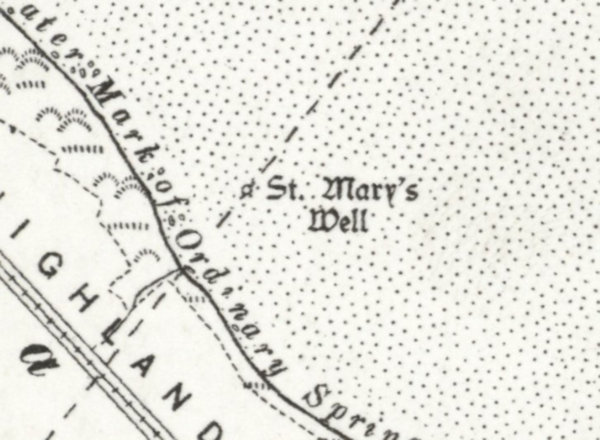 |
Dedication: Saint Mary the Virgin Location: Tain Coordinates: 57.820337N, -4.0610569W Grid reference: NH776830 Heritage designation: none |
 |
Dedication: Saint Mary the Virgin Location: Tain Coordinates: 57.820337N, -4.0610569W Grid reference: NH776830 Heritage designation: none |
Tain's holy well is unusual in the fact that, for much time each day, it is covered by the sea. It is unclear how or why this particular spring became associated with the Virgin Mary, as every one of Tain's medieval churches are dedicated to St Duthus, who was reputedly born in Tain, and is the patron saint of the town. Tain was in fact a small centre of pilgrimage during the medieval era; the shrine of St Duthus, which contained his relics, attracted many pilgrims, including King James IV, who visited Tain at least seventeen times. On one of his many visits to see St Duthus' relics, the king gifted a unicorn to the shrine. He doubtlessly visited St Mary's Well on at least one of these pilgrimages.
St Mary's Well was believed to be particularly effective in the curing of tuberculosis. On account of the fact that the well is located below the high water mark, it is impossible to access the spring at certain times of day, and it became a local belief that, for the patient to be healed, they would have to visit the well as early in the morning as was possible, and drink the water on the spot. This practice was described in The New Statistical Account of Scotland: Inverness, Ross and Cromarty, which was published in 1845:
|
Perhaps the most remarkable spring in the parish, is one called St Mary's Well, which is every day covered for several hours by the salt sea; on the retiring of which, its refreshing waters may be procured. It was, of old, reckoned a specific remedy for consumption; though we believe it was essential to its efficacy, that it should be drunk early in the morning, and upon the spot... |
It also appears that the well has, for a very long time, marked the parish boundary, which signifies its early significance in the community. During the 19th and early 20th centuries, the well was evidently still of some importance in the town, even if its supposed healing powers had been long since forgotten. An image of the well, which was taken at some point in the 1930s, and can be seen on Tain Museum's website. It depicts Georgina Macdonald, who often collected water from the well, and who is said to have surrounded the spring with stones.
The well has always been marked and named on Ordnance Survey maps, and it still is today, so it can only be assumed that the site still exists, although its exact condition is unrecorded.
|
Access: The well is located in the middle of the beach, so tide times should certainly be checked. Look out for three large blocks of stone: according to Tain Museum's website, these will help to locate the well. |
Copyright 2025 britishholywells.co.uk